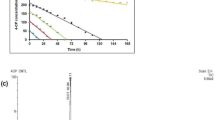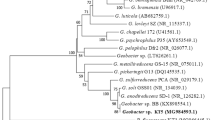Abstract
Compound-specific stable isotope analysis provides an alternative method to insight into the biotransformation mechanisms of diffuse organic pollutants in the environment, e.g., the endocrine disruptor herbicide atrazine. Biotic hydrolysis process catalyzed by chlorohydrolase AtzA and TrzN plays an important role in the detoxification of atrazine, while the catalytic mechanism of AtzA is still speculative. To investigate the catalytic mechanism of AtzA and answer whether both enzymes catalyze hydrolytic dechlorination of atrazine by the same mechanism, in this study, apparent kinetic isotope effects (AKIE) for carbon and nitrogen were observed by three atzA-harboring bacterial isolates and their membrane-free extracts. The AKIEs obtained from atzA-harboring bacterial isolates (AKIEC = 1.021 ± 0.010, AKIEN = 0.992 ± 0.003) were statistically different from that of trzN-harboring strains (AKIEC = 1.040 ± 0.006, AKIEN = 0.983 ± 0.006), confirming the different activation mechanisms of atrazine preceding to nucleophilic aromatic substitution of Cl atom in actual enzymatic reaction catalyzed by AtzA and TrzN, despite the limitation of variable dual-element isotope plots. The lower degree of normal carbon and inverse nitrogen isotope fractionation observed from atzA-harboring strains, suggesting AtzA catalyzing hydrolytic dechlorination of atrazine by coordination of Cl and one aromatic N to the Fe2+ drawing electron density from carbon-chlorine bond that facilitating the nucleophilic attack, rather than in TrzN case that protonation of aromatic N increasing nucleophilic substitution of Cl atom. This study suggests considering the potential influences of phylogenetic diversity of bacterial isolates and evolution of enzymes on the applications of CSIA method in future study.





Similar content being viewed by others
References
Anna G, Rafal K, Agnieszka D-D (2014) Theoretical predictions of isotope effects versus their experimental values for an example of uncatalyzed hydrolysis of atrazine. Phys Chem Chem Phys 16:15164–15172
Betts SK (2002) More evidence that atrazine may affect frog sexuality. Environ Sci Technol 36:444A
Busing J, Buchner D, Behrens S, Haderlein SB (2020) Deciphering the variability of stable isotope (C, Cl) fractionation of tetrachloroethene biotransformation by Desulfitobacterium strains carrying different reductive dehalogenases enzymes. Environ Sci Technol 54:1593–1602
Chen S, Yang P, Rohit Kumar J, Liu Y, Ma L (2017) Inconsistent carbon and nitrogen isotope fractionation in the biotransformation of Atrazine by Ensifer sp. CX-T and Sinorihizobium sp. K. Int Biodeterior Biodegrad 125:170–176
Cook PF, Cleland WW (1981) Mechanistic deductions from isotope effects in multireactant enzyme mechanisms. Biochemistry 20:1790–1796
Coplen TB (2011) Guidelines and recommended terms for expression of stable-isotope-ratio and gas-ratio measurement results. Rapid Commun Mass Spectrom 25:2538–2560
Dybala-Defratyka A, Szatkowski L, Kaminski R, Wujec M, Siwek A, Paneth P (2008) Kinetic isotope effects on dehalogenations at an aromatic carbon. Environ Sci Technol 42:7744–7750
Ehrl BN, Gharasoo M, Elsner M (2018) Isotope fractionation pinpoints membrane permeability as a barrier to atrazine biodegradation in gram-negative Polaromonas sp. Nea-C. Environ Sci Technol 52:4137–4144
Ehrl BN, Kundu K, Gharasoo M, Marozava S, Elsner M (2019) Rate-limiting mass transfer in micropollutant degradation revealed by isotope fractionation in chemostat. Environ Sci Technol 53:1197–1205
Elsner M (2010) Stable isotope fractionation to investigate natural transformation mechanisms of organic contaminants: principles, prospects and limitations. J Environ Monit 12:2005–2031
Elsner M, Imfeld G (2016) Compound-specific isotope analysis (CSIA) of micropollutants in the environment - current developments and future challenges. Curr Opin Biotechnol 41:60–72
Elsner M, Zwank L, Hunkeler D, Schwarzenbach R (2005) A new concept linking observable stable isotope fractionation to transformation pathways of organic pollutants. Environ Sci Technol 39:6896
Elsner M, McKelvie J, Couloume GL, Lollar BS (2007) Insight into methyl tert-butyl ether (MTBE) stable isotope fractionation from abiotic reference experiments. Environ Sci Technol 41:5693–5700
Elsner M, Jochmann MA, Hofstetter TB, Hunkeler D, Bernstein A, Schmidt TC, Schimmelmann A (2012) Current challenges in compound-specific stable isotope analysis of environmental organic contaminants. Anal Bioanal Chem 403:2471–2491
Fenner K, Canonica S, Wackett LP, Eisner M (2013) Evaluating pesticide degradation in the environment: blind spots and emerging opportunities. Science 341:752–758
Ghirardelli A, Otto S, Masin R, Bano C, Zanin G (2020) Thirty-year monitoring of s-triazine herbicide contamination in the aquifer north of Vicenza (north-east Italy). Sci Total Environ 752:141647
Govantes F, Garcia-Gonzalez V, Porrua O, Isabel Platero A, Jimenez-Fernandez A, Santero E (2010) Regulation of the atrazine-degradative genes in Pseudomonas sp strain ADP. FEMS Microbiol Lett 310:1–8
Heckel B, Phillips E, Edwards E, Sherwood Lollar B, Elsner M, Manefield MJ, Lee M (2019) Reductive dehalogenation of trichloromethane by two different dehalobacter restrictus strains reveal opposing dual element isotope effects. Environ Sci Technol 53:2332–2343
Hohener P, Imfeld G (2021) Quantification of Lambda (Lambda) in multi-elemental compound-specific isotope analysis. Chemosphere 267:129232
Huang C, Zeng Y, Cao Y, Zhu C, Ren Z, Liu Y-E, Gao S, Tian Y, Luo X, Mai B (2021) Mechanistic aspects regarding the ultraviolet degradation of polychlorinated biphenyls in different media: insights from carbon and chlorine isotope fractionation. Environ Sci Technol 55:7731–7740
Jin B, Rolle M (2016a) Joint interpretation of enantiomer and stable isotope fractionation for chiral pesticides degradation. Water Res 105:178–186
Jin B, Rolle M (2016b) Position-specific isotope modeling of organic micropollutants transformation through different reaction pathways. Environ Pollut 210:94–103
Jia L, Hai L, Yingbo D, Bing L (2019) Elucidating the biodegradation mechanism of tributyl phosphate (TBP) by Sphingomonas sp. isolated from TBP-contaminated mine tailings. Environ Pollut. https://doi.org/10.1016/j.envpol.2019.03.127
Katarzyna Ś, Paneth P (2013) Binding isotope effects. Chem Rev. https://doi.org/10.1021/cr300515x
Khan AM, Wick LY, Thullner M (2018) Applying the Rayleigh approach for stable isotope-based analysis of VOC biodegradation in diffusion-dominated systems. Environ Sci Technol 52:7785–7795
Lihl C, Heckel B, Grzybkowska A, Dybala-Defratyka A, Ponsin V, Torrento C, Hunkeler D, Elsner M (2020) Compound-specific chlorine isotope fractionation in biodegradation of atrazine. Environ Sci-Processes Impacts 22:792–801
Ma L, Chen S, Yuan J, Yang P, Liu Y, Stewart K (2017) Rapid biodegradation of atrazine by Ensifer sp. strain and its degradation genes. Int Biodeterior Biodegrad 116:133–140
Maier MP, de Corte S, Nitsche S, Spaett T, Boon N, Elsner M (2014) C & N isotope analysis of diclofenac to distinguish oxidative and reductive transformation and to track commercial products. Environ Sci Technol 48:2312–2320
Masbou J, Drouin G, Payraudeau S, Imfeld G (2018) Carbon and nitrogen stable isotope fractionation during abiotic hydrolysis of pesticides. Chemosphere 213:368–376
Meyer AH, Elsner M (2013) C-13/C-12 and N-15/N-14 isotope analysis to characterize degradation of atrazine: evidence from parent and daughter compound values. Environ Sci Technol 47:6884–6891
Meyer AH, Penning H, Lowag H, Elsner M (2008) Precise and accurate compound specific carbon and nitrogen isotope analysis of atrazine: critical role of combustion oven conditions. Environ Sci Technol 42:7757–7763
Meyer AH, Penning H, Elsner M (2009) C and N isotope fractionation suggests similar mechanisms of microbial atrazine transformation despite involvement of different enzymes (AtzA and TrzN). Environ Sci Technol 43:8079–8085
Noor S, Changey F, Oakeshott JG, Scott C, Martin-Laurent F (2014) Ongoing functional evolution of the bacterial atrazine chlorohydrolase AtzA. Biodegradation 25:21–30
Ojeda AS, Zheng J, Phillips E, Lollar BS (2021) Implications of regression bias for multi-element isotope analysis for environmental remediation. Talanta 226:122113
Peat TS, Newman J, Balotra S, Lucent D, Warden AC, Scott C (2015) The structure of the hexameric atrazine chlorohydrolase AtzA. Acta Crystallogr D 71:710–720
Renpenning J, Rapp I, Nijenhuis I (2015) Substrate hydrophobicity and cell composition influence the extent of rate limitation and masking of isotope fractionation during microbial reductive dehalogenation of chlorinated ethenes. Environ Sci Technol 49:4293–4301
Scheuring J, Schramm VL (1997) Kinetic isotope effect characterization of the transition state for oxidized nicotinamide adenine dinucleotide hydrolysis by pertussis toxin. Biochemistry 36:4526–4534
Schilling IE, Hess R, Bolotin J, Lal R, Hofstetter TB, Kohler H-PE (2019) Kinetic isotope effects of the enzymatic transformation of gamma-hexachlorocyclohexane by the lindane dehydrochlorinase variants LinA1 and LinA2. Environ Sci Technol 53:2353–2363
Schramm VL (1998) Enzymatic transition states and transition state analog design. Annu Rev Biochem 67:693–693
Schuerner HKV, Seffernick JL, Grzybkowska A, Dybala-Defratyka A, Wackett LP, Elsner M (2015) Characteristic isotope fractionation patterns in s-triazine degradation have their origin in multiple protonation options in the s-triazine hydrolase TrzN. Environ Sci Technol 49:3490–3498
Scott KM, Lu X, Cavanaugh CM, Liu JS (2004) Optimal methods for estimating kinetic isotope effects from different forms of the Rayleigh distillation equation. Geochim Cosmochim Acta 68:433–442
Scott C, Jackson CJ, Coppin CW, Mourant RG, Hilton ME, Sutherland TD, Russell RJ, Oakeshott JG (2009) Catalytic improvement and evolution of atrazine chlorohydrolase. Appl Environ Microbiol 75:2184–2191
Seffernick JL, Wackett LP (2001) Rapid evolution of bacterial catabolic enzymes: a case study with atrazine chlorohydrolase. Biochemistry 40:12747–12753
Seffernick JL, Reynolds E, Fedorov AA, Fedorov E, Almo SC, Sadowsky MJ, Wackett LP (2010) X-ray structure and mutational analysis of the atrazine chlorohydrolase TrzN. J Biol Chem 285:30606–30614
Shapir N, Rosendahl C, Johnson G, Andreina M, Sadowsky MJ, Wackett LP (2005) Substrate specificity and colorimetric assay for recombinant TrzN derived from Arthrobacter aurescens TC1. Appl Environ Microbiol 71:2214
Thullner M, Fischer A, Richnow H-H, Wick LY (2013) Influence of mass transfer on stable isotope fractionation. Appl Microbiol Biotechnol 97:441–452
Vogt C, Dorer C, Musat F, Richnow H-H (2016) Multi-element isotope fractionation concepts to characterize the biodegradation of hydrocarbons—from enzymes to the environment. Curr Opin Biotechnol 41:90–98
Vonberg D, Vanderborght J, Cremer N, Puetz T, Herbst M, Vereecken H (2014) 20 years of long-term atrazine monitoring in a shallow aquifer in western Germany. Water Res 50:294–306
Won E-J, Yun H-Y, Lee D-H, Shin K-H (2021) Application of compound-specific isotope analysis in environmental forensic and strategic management avenue for pesticide residues. Molecules 26:4412
Wu L, Verma D, Bondgaard M, Melvej A, Vogt C, Subudhi S, Richnow HH (2018) Carbon and hydrogen isotope analysis of parathion for characterizing its natural attenuation by hydrolysis at a contaminated site. Water Res 143:146–154
Wu L, Liu Y, Liu X, Bajaj A, Sharma M, Lal R, Richnow HH (2019) Isotope fractionation approach to characterize the reactive transport processes governing the fate of hexachlorocyclohexanes at a contaminated site in India. Environ Int 132:105036
Zhang N, Bashir S, Qin J, Schindelka J, Fischer A, Nijenhuis I, Herrmann H, Wick LY, Richnow HH (2014) Compound specific stable isotope analysis (CSIA) to characterize transformation mechanisms of α-hexachlorocyclohexane. J Hazard Mater 280:750–757
Zhao X, Bai S, Li C, Yang J, Ma F (2019) Bioaugmentation of atrazine removal in constructed wetland: performance, microbial dynamics, and environmental impacts. Bioresour Technol 289:121618
Acknowledgements
Financial support was provided by National Key R&D Program of China (Grant: 2018YFC1803100)
Author information
Authors and Affiliations
Corresponding authors
Ethics declarations
Conflict of interest
The authors declare that they have no known competing financial interests or personal relationships that could have appeared to influence the work reported in this paper.
Additional information
Publisher's Note
Springer Nature remains neutral with regard to jurisdictional claims in published maps and institutional affiliations.
Supplementary Information
Below is the link to the electronic supplementary material.
Rights and permissions
About this article
Cite this article
Chen, S., Ma, L. & Wang, Y. Kinetic isotope effects of C and N indicate different transformation mechanisms between atzA- and trzN-harboring strains in dechlorination of atrazine. Biodegradation 33, 207–221 (2022). https://doi.org/10.1007/s10532-022-09977-y
Received:
Accepted:
Published:
Issue Date:
DOI: https://doi.org/10.1007/s10532-022-09977-y




